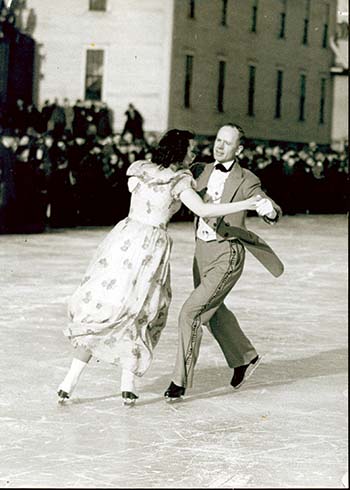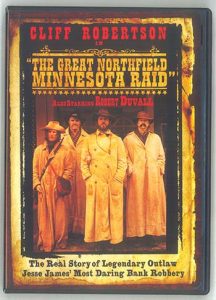
Those of you who have been amazed at the magnificence (and length) of the Defeat of Jesse James Days parades will no doubt be even more amazed to learn that once upon a time Northfield held two parades in one day. And these two parades did not take place in September but on a 20-degree day in January. Not only that, but another huge parade had been held just two weeks earlier!
“St. Paul Clubs to March Here for Carnival” was the headline for a Jan. 9, 1941, Northfield News story, accompanied by a photo of the royalty of the 1941 St. Paul Winter Carnival, Rex Boreas VI and the Queen of the Snows. Two trainloads of around 1500 people, including ten drum and bugle corps, bands and other marching units, came to promote the St. Paul event by taking part in a parade on Jan. 12. The parade was deemed “probably the best ever seen in Northfield” by the Northfield Independent on Jan. 16. Thousands of sightseers came to the late Sunday morning parade, though there were “a number of protests” over the conflict with the “regular hour of worship.” The trains continued on to Faribault for the afternoon. W.F. Schilling grumbled in his “Tales of the Town” column that “the horses were not taken off the train at Northfield but were held back for observance by our big sister city down the line where many of the urbanites had never seen a mounted horse.”
The visit was a prelude to Northfield’s first Winter Carnival, held Jan. 24-26. The first activity of the weekend was a basketball game between the high schools of Northfield and Faribault in which Northfield avenged an earlier last-minute defeat with a one-point win. King North I, William Revier, and his queen, Lucille Elstad, were crowned after the game, with a coronation ball following at the Armory. The Jan. 30 Northfield Independent said that Dan Freeman, general chairman of the Northfield Winter Carnival, “narrowly escaped a crowning of the less festive kind” after the coronation when a loudspeaker dropped from the ceiling to the stage just after the ceremony. (This Dan Freeman was the uncle of Northfield’s current Dan Freeman.)
Saturday’s events included speed skating races, cross-country and downhill ski races, dog sled races, hockey games, an amateur show at the NHS auditorium and a “Big Carnival Dance” at the Armory. The Dog Derby was held above the Fifth Street bridge Saturday afternoon on the Cannon River. There were four entries and four prizes, thus satisfying all the contestants, said the Northfield News on Jan. 30, adding: “The boys and their dogs had a lot of fun, as did the rumored 15,000 spectators who watched the race. With the schools so full of husky young boys and so many dogs roaming the streets of Northfield, it seems too bad that there couldn’t have been a larger registration for this event.” An ice palace on Bridge Square, illuminated by electric lights at night, “formed a pleasing spectacle,” in the words of the Northfield Independent of Jan. 30. There was a snow sculpturing contest and the skating races were held on the city skating rink on the river, which was also open for community skating. The hills on the Carleton campus were available for skiing and tobogganing, while the competitive downhill and cross country skiing events were held at Heath Creek Saturday afternoon.
The first Sunday parade featured floats, the NHS band, service clubs and marching clubs and drum and bugle corps, which had come down in a special train from St. Paul. The Ice Revue of 1941 was put on in the afternoon at the Cannon River skating rink above the dam by the 50 members of the St. Paul Figure Skating Club. The Northfield Independent reported on Jan. 30 that there was “ideal winter weather, with bright sunshine and no wind and with the ice in excellent condition. The St. Paul skaters put on a beautiful and clever performance that was greatly enjoyed by the spectators that crowded onto the ice and lined the banks of the river.” Four of the performers, with brand new costumes, comprised a skating group that had won an American championship. A highlight was Patsy Phillippi (“famed as the only drum majorette skater in the big St. Paul Winter Carnival”) leading a large group of skaters in an “America First” number. There were also solo and other group numbers on ice (including a “spirited rhumba”) and comedy routines.
Yet another group of St. Paul Winter Carnival boosters promoting their own upcoming carnival paraded in Northfield in the evening, on their way back to St. Paul after train stops in Owatonna, Albert Lea and Austin. Estimated attendance at Sunday events was 10,000. A group of Northfielders planned to participate on horseback in “Jesse James attire” in a St. Paul Winter Carnival parade “to reciprocate in a small way for the many paraders who came from St. Paul to help make Northfield’s winter carnival a success,” according to the Northfield News story of Jan. 30.

The first Northfield Winter Carnival was a financial success, with a small surplus for the next year’s carnival. The second annual Winter Carnival (held Jan, 16-18, 1942) was set to feature a presentation of the Star Spangled Ice Revue, “one of the leading figure skating shows touring the United States today.” The Northfield News of Jan. 15 reported that Dot Franey, the youngest champion at the 1932 Lake Placid Olympics and a repeat champion in Germany in 1936 who once held every speed skating championship, had assembled international figure skaters to perform free of charge on the city rink. But it was not to be.
Things went awry quickly. Ice palace plans had to be dropped when a January thaw led to ice blocks only two inches thick for the building material. A big float, in the form of an ice palace, was used instead on Bridge Square. The Friday carnival dance went on as planned at the Armory, with the coronation of “Northfield’s genial postmaster,” Carl C. Heibel (father of current Northfield resident Dick Heibel), as King North II and Carleton senior Virginia Millis as Queen, both wearing royal purple velvet costumes and crowns of gold. But since almost all the snow had disappeared, Saturday’s winter sports events were cancelled and on Sunday afternoon, “when the main ice skating events were scheduled, the local rink was covered with a sheet of water,” according to the Northfield Independent on Jan. 22.
Although the Sunday afternoon parade got underway late and the number of local floats was said to be lower than the previous year, spirit was provided by representatives of the St. Paul Winter Carnival, including several drum and bugle corps, marching units and King Boreas. Among the out-of-town marchers were Mother’s Friend Laundry and the Frogtown and Peter Sausage Company’s Drum and Bugle corps. Along with the NHS band, a group of Northfielders “dressed in golf togs and carrying golf bags” formed a unit in the parade that “added a touch of irony as well for the brand of weather provided for the Winter Carnival,” said the Northfield News. The Northfield Independent commented that the sidewalks were lined for blocks with people enjoying the sun and the parade.
Several Northfield women were interviewed Thursday before the 1942 Carnival started and their remarks were broadcast on a “Meet the Missus” WCCO morning radio show on Friday. The Northfield Carnival Queen Virginia Millis sent out a message to all Northfield men in the Army and Navy over the air waves. Though another king and queen were chosen to reign in 1943, the widening of World War II put a damper on carnival celebrations and ended the two-year Winter Carnival tradition in town.
In 1948, however, another yearly tradition, with its own parades and activities, began: the September celebration of the defeat of the James-Younger Gang in 1876.
“Where have you gone, Joe DiMaggio?” To Northfield!
Early in the week of Northfield’s first Winter Carnival, the town had a special visitor: Joe DiMaggio. DiMaggio had arrived in town on Sunday, Jan. 19, with his wife, Dorothy Arnold, whose sister Leone lived in Northfield.
So it was that the Northfield Lions Club luncheon on Monday noon of the 20th was “honored by the presence” of the “base ball player extraordinary of the New York Yankees,” as reported in the Northfield Independent of Jan. 23, 1941. DiMaggio was introduced by his brother-in-law, Orville Dahl (who went on to become the first president of California Lutheran University in Thousand Oaks, Cal.). The newspaper said, “Joe, in his modest and unassuming manner, took a gracious bow and generously autographed baseballs and cards for the fans present” and after the luncheon, “an informal group gathered around Joe DiMaggio and talked baseball.”
The program, which DiMaggio saw along with the others, was presented by Dr. Fredrick A. Heiberg (father of current Northfield resident, Dr. Elvin Heiberg), who showed colored movies taken during a trip through New England, New York and Washington, D.C. Described as a “master of color photography,” Dr. Heiberg (a dentist) also showed the first official motion pictures of the Jan. 1 parade staged in Northfield by marching clubs to preview the St. Paul Winter Carnival.
Joe DiMaggio and his wife, Dorothy, stayed at the home of the Dahls on St. Olaf Avenue. Orville Dahl was an assistant dean of men and English instructor at St. Olaf and Leone had worked as an assistant in the St. Olaf College Library, so it is not surprising that the Northfield News story on Jan. 23 noted that the DiMaggios “have visited St. Olaf College.” They also were guests Monday night at a gathering at the home of Dr. and Mrs. Leonard Amodt. The Northfield Independent of Jan. 23 said, “This is Mr. DiMaggio’s first experience with a northern winter, and he claims he likes it.”
The DiMaggios, who lived in San Francisco, had been visiting Dorothy’s relatives in Rice Lake, Wis., and in Duluth before coming to Northfield. She was born Dorothy Arnoldine Olson in Duluth in 1917, daughter of a railroad conductor. DiMaggio had met the aspiring blonde actress in the Bronx on the set of a film called “Manhattan Merry-Go-Round” in 1937 and they married in San Francisco on Nov. 19, 1939, as 10,000 “uninvited guests” tried to catch a glimpse of the couple. Life Magazine reported that it took 15 minutes for the wedding party to battle their way inside the church. The marriage was over by 1944 and DiMaggio went on to marry another blonde (and more famous movie actress), Marilyn Monroe.
The Northfield newspaper accounts of the 1941 visit concluded by saying that Joe DiMaggio was due at the Yankee spring training camp in St. Petersburg, Fla., on March 1. It is interesting to remember that Joltin’ Joe DiMaggio’s famous 56-game hitting streak started on May 15, 1941, about four months after his visit to Northfield. He hit safely in every game until July 17, a record that is considered one of baseball’s most outstanding achievements. I don’t suppose his visit to our town can be credited with inspiration for the streak, but still…






